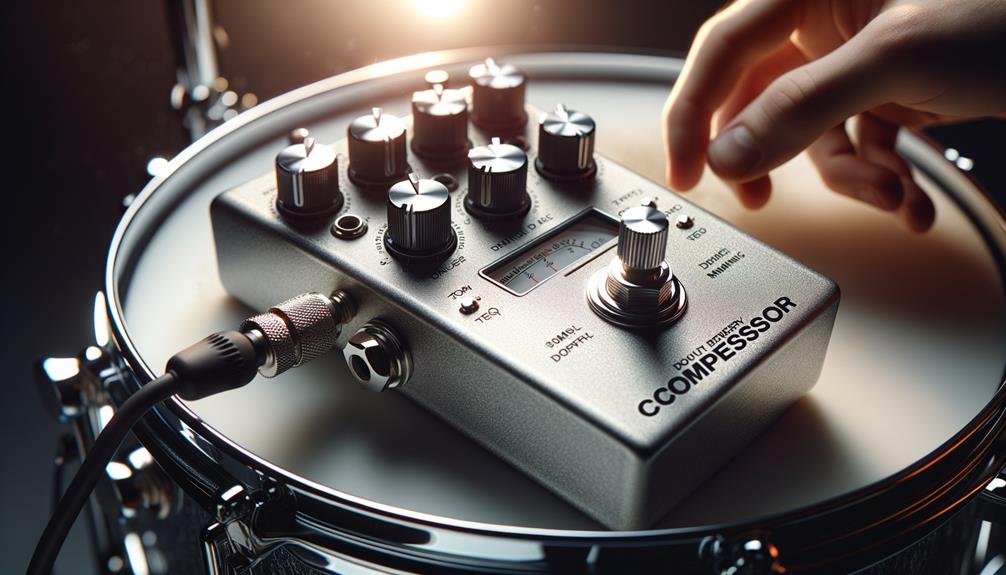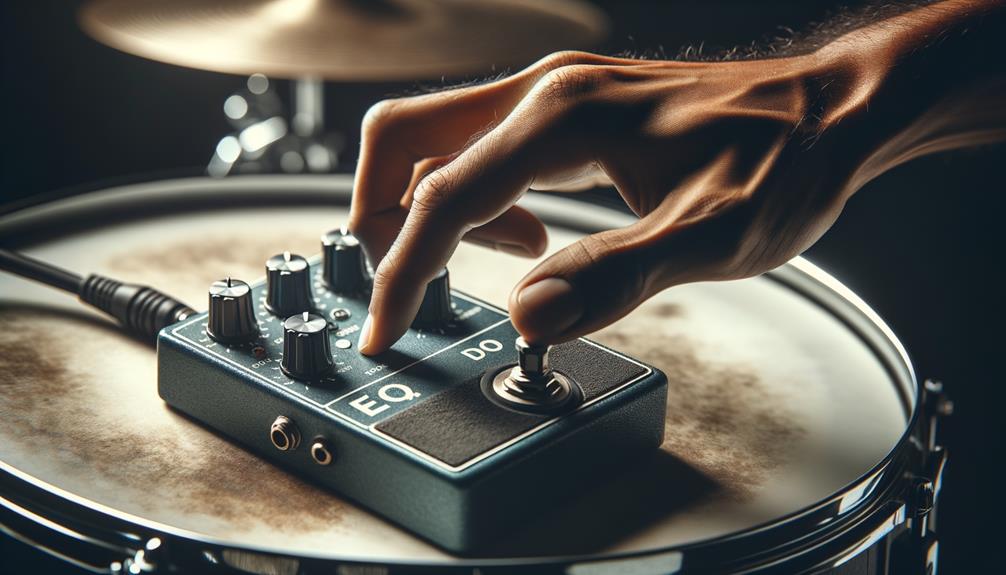No products in the cart.
When it comes to EQing your toms, think of it as sculpting a piece of clay. Just like a sculptor carefully shapes and molds their creation, you have the power to shape and mold the sound of your toms.
But how do you achieve that perfect balance and clarity in your toms’ sound? Let’s explore some effective techniques to help you carve out the ideal tom tone that will make your mix stand out.
Contents
hide
Key Takeaways
- EQ adjustments can greatly impact the overall sound of drums, including toms.
- Cutting middle frequencies creates space for the lows and highs to shine.
- Boosting higher frequencies can add attack and presence to toms without overpowering.
- Finding the right balance between the highs and lows is crucial for achieving a well-rounded tom sound.
Understanding Tom Frequencies
To understand tom frequencies, it’s crucial to grasp the impact of EQ adjustments on the overall drum sound. When EQing toms, it’s essential to consider the key frequencies that contribute to their character. By manipulating the EQ, you can enhance the low end to provide a thicker and more powerful tom sound. Cutting middle frequencies creates space for the lows and highs to shine through, resulting in a more balanced and defined tonal quality. Additionally, boosting higher frequencies can add attack to the toms without overpowering the mix. It’s important to find the right balance, perhaps using a broad but small boost for the highs to complement the lows effectively.
In metal mixes, understanding tom frequencies becomes even more crucial. Experimenting with slight boosts and cuts at specific frequencies can help eliminate mud and enhance the overall clarity of the toms. Additionally, using a transient designer-esque plugin can further enhance the stick or smack of the toms, contributing to a more dynamic and impactful sound. In some cases, utilizing a gate for each tom individually can help remove unwanted noise from other drums, further refining the tom sound.
Furthermore, blending in samples alongside the raw mics can provide reinforcement, particularly in metal mixes where a powerful and precise tom sound is essential.
Techniques for Tom EQ
Understanding tom frequencies and their impact on the overall drum sound, you can employ specific techniques for EQ to enhance the character and clarity of the toms. When EQing toms, it’s essential to start with the fundamental frequencies and adjust from there.
A good starting point is to cut the mids around 300 Hz to create space for the lows and highs in the mix, allowing the toms to punch through without muddying up the sound.
For big floor toms, adding more lows in the 80-100 Hz range can provide a thicker, more pronounced sound. To enhance the attack of the toms without overpowering the mix, a shelving boost in the higher frequencies, particularly in the 1.2 kHz – 5 kHz range, can be beneficial.
Additionally, a gentle high shelf boost can complement the lows and bring out the clarity in the toms.
Using Compression for Tom EQ

When using compression for tom EQ, consider applying a medium attack (6:1 ratio) to enhance the power and impact of the toms in the mix. This setting allows the initial transients of the drum recordings to come through, adding clarity and punch to the sound. Additionally, parallel compression can be used to further emphasize the dynamics of the floor toms, giving them a larger-than-life presence in the mix. By blending the heavily compressed signal with the dry signal, you can achieve a balanced sound with enhanced sustain and power.
| Compression Setting | Impact |
|---|---|
| Medium attack (6:1 ratio) | Enhances initial transients, adding punch |
| Parallel compression | Emphasizes dynamics, creates larger-than-life presence |
| EQ Control | Shapes the tone, allowing toms to cut through the mix |
Applying a small boost in the low frequencies (around 80-100Hz for floor toms) can thicken the sound, while boosting higher frequencies (1.2kHz – 5kHz) can help the toms cut through the mix. Utilizing compression for drums, in combination with strategic EQ adjustments, allows for precise control over the tonal and dynamic aspects of the toms, resulting in a powerful and impactful drum sound.
Applying Reverb to Toms
After enhancing the power and impact of the toms with compression, the next step is to apply reverb to add depth and space to the sound. Experiment with different reverb lengths to find the right balance between a natural sound and a larger-than-life effect. Utilize short reverbs and consider panning them behind each tom to create a dynamic, immersive sound.
For a focused sound and to avoid cluttering the stereo image, use mono reverbs. When applying reverb, follow these steps to quickly achieve a thunderous tom sound.
- First, insert a reverb send on the tom track and dial in the desired reverb type and length.
- Next, apply a high pass filter to the reverb to remove any unwanted low frequencies.
- Adjust the reverb’s pre-delay to create separation between the dry tom sound and the reverb tail.
- Finally, tweak the reverb’s mix level to blend it with the dry tom sound, ensuring that the reverb enhances the toms without overpowering them.
Tips for Polishing Tom Sound


To achieve a polished tom sound, carefully apply equalization to shape the sonic character, enhancing its clarity and impact within the mix. Start by cutting mid frequencies around 300Hz to create space for lows and highs, allowing for enhanced clarity and definition. Additionally, add more lows in the range of 80-100Hz for a fuller tom sound, particularly beneficial for larger floor toms. To further enhance the attack and presence of the toms, boost higher frequencies between 1.2 kHz and 5 kHz. This will add the necessary punch without overpowering the overall mix. Consider using a broad but subtle boost for the highs to complement the lows, achieving a balanced and well-defined tom sound.
When polishing tom sound, it’s crucial to remember to EQ before compressing to preserve the natural dynamics and tonal characteristics of the drums. Additionally, consider using compression for drums to further enhance the impact and sustain of the toms within the mix.
With these tips in mind, you can sculpt the perfect tom sound that seamlessly fits with the kick drum, electric guitar, and other elements in your mix. For more in-depth techniques on achieving a polished tom sound, download our FREE GUIDE on drum mixing.
Frequently Asked Questions
What Is the Best EQ Setting for Toms?
For the best EQ setting for toms, start with drum head selection, mic placement, and drum tuning. Consider room acoustics, compression techniques, and drum mixing. Experiment with EQ techniques to achieve desired tom sound.
How Do You Make Toms Sound Punchy?
To make toms sound punchy, tune the drums well, experiment with compression techniques, optimize drum mic placement, consider room acoustics, select appropriate drum heads, use drum dampening, and apply innovative drum mixing techniques.
What Is the Best Frequency for Toms?
For optimal tom tuning, consider drum mic placement, room acoustics, and drum head selection. Utilize compression techniques like parallel compression for added impact. Experiment with EQ techniques to cut mid frequencies and boost lows and highs for a thicker tom sound.
How Do I Make My Toms Less Boomy?
To make your toms less boomy, try muffling techniques like using moon gels or tape. Experiment with different drum head selections, adjust mic placement, consider room acoustics, and focus on precise drum tuning. Use gentle compression and EQ troubleshooting to refine the sound.
Conclusion
Now that you understand the techniques for EQing toms effectively, you can improve the sound of your toms by cutting the middle frequencies, adding more lows for thickness, and boosting higher frequencies for attack.
Utilize compression with a medium attack and a 6:1 ratio to enhance the power of the toms.
Lastly, consider applying reverb to add depth and polish to the overall tom sound.
With these tips, you can achieve professional and impactful tom sound in your mixes.




